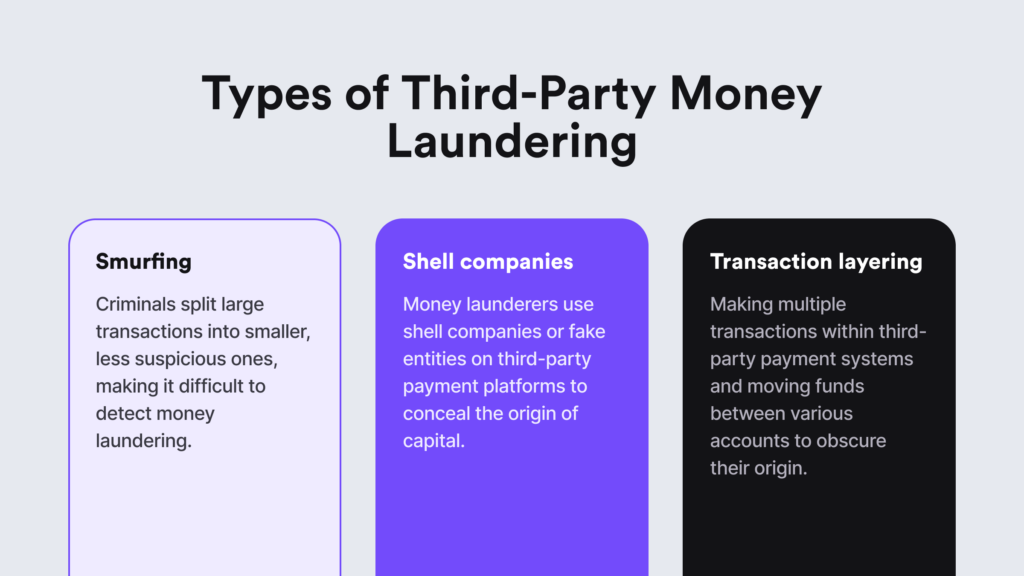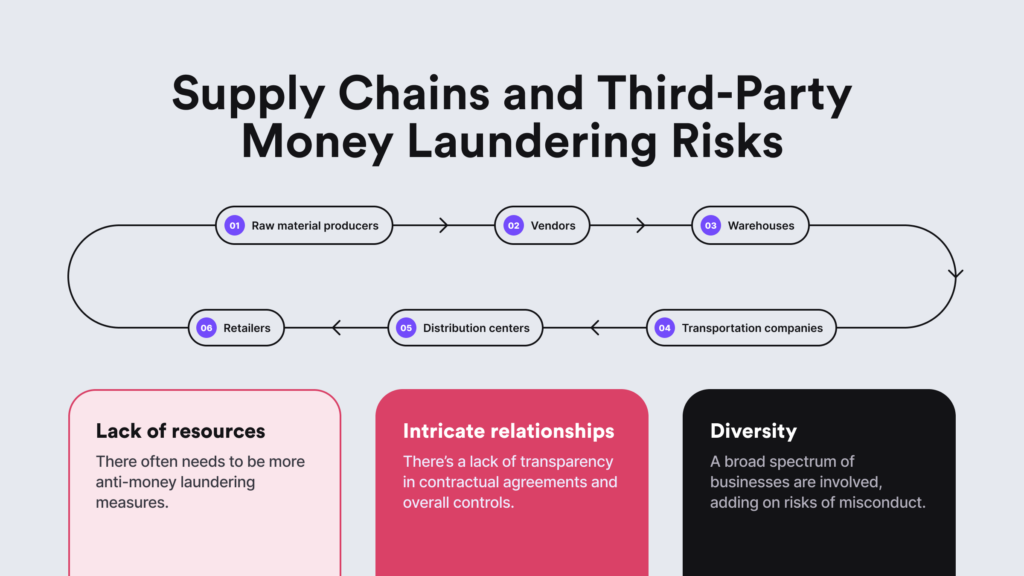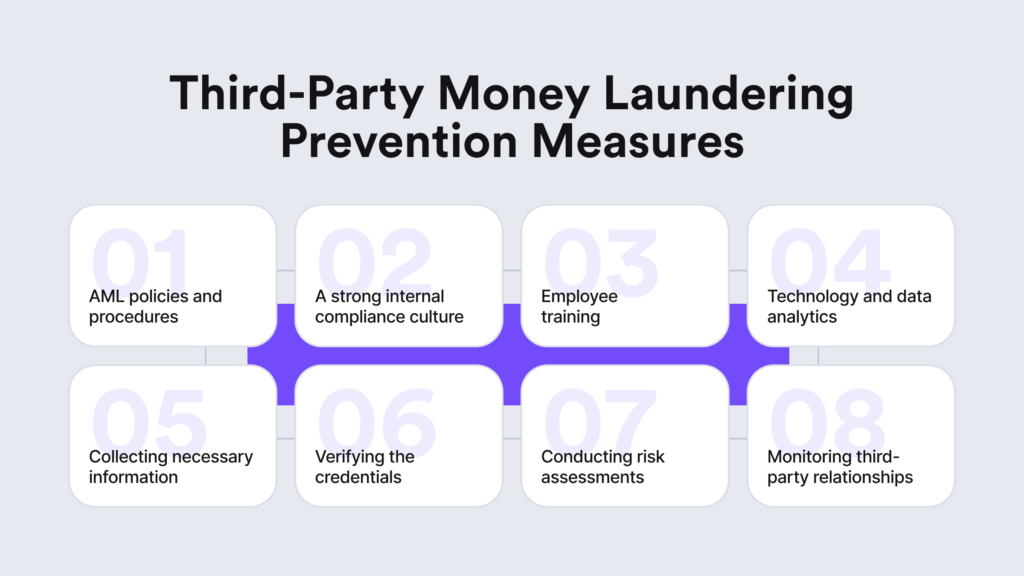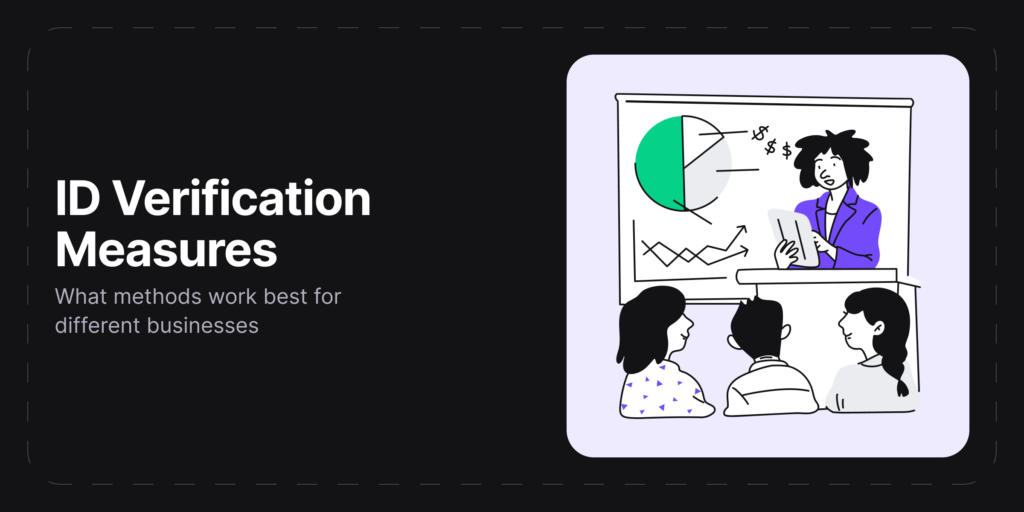Third parties, such as suppliers, partners, vendors, or other service providers, often have access to internal company or customer data, systems, processes, or other sensitive information. If a business collaborates with supply-chain partners or outsources at least a part of its operations, the company automatically should be aware of third-party money laundering risks.
Third-party risk, especially in the context of money laundering, is a significant concern for businesses of all sizes, from large corporations to small enterprises. Vendors can use client accounts to hide money from illegal activities. To prevent this, companies should verify not just their customers but also their partners, where the money is coming from, and if any third parties are involved.
Money laundering is a big worry that these third parties can bring to both the supply chain and the company. There are other dangers, too, like compliance challenges, legal problems, and harm to the company’s reputation.
That’s why companies should actually prioritize compliance and data protection and not rely only on outdated tools or practices that lack proper security measures to keep customers safe.
What is Third-Party Money Laundering?
Third-party money laundering is the process of using another company, like a payment service provider or supplier, to hide illicit funds. This can happen through different methods, for example, through trade-based schemes, or online payment platforms. Sometimes, third parties might “help” with money laundering schemes unknowingly.
Criminals use intricate ways to exploit third parties. For example, they use trade-based money laundering to manipulate trade transactions and move illicit funds across borders. Using this form of third-party money laundering, criminals falsify trades and exploit international trade complexities, blending dirty money into the legal economy.

The Role of the Supply Chain and Third Parties
A supply chain consists of all participants involved in creating and delivering a product, from raw material producers to end consumers. It requires a seamless flow of all activities for it to work.
Third-party entities can serve as:
- Suppliers
- Logistics provider
- Distribution centers
Understanding the role of third parties is vital for businesses aiming to optimize their supply chain and ensure smooth product delivery. Third-party relationships enhance a company’s capabilities by providing expertise in navigating regulations like legal compliance. They also offer valuable insights and fresh perspectives for long-term business development opportunities.
While this looks like pure benefits for companies, there’s a darker side to the operational landscape of third parties. Carefully managing third-party relationships is crucial to maximize benefits and mitigate risks like money laundering.
Why are Third Parties Vulnerable to Money Laundering?
Money laundering through third parties uses legal transactions to hide where illegal money comes from. Criminals choose this channel on purpose because it helps them keep their distance from the dirty money, making it harder to detect and follow.
What’s worse is that although the main company might have strong internal anti-money laundering (AML) compliance measures, third-party companies may not stick to the same level of scrutiny against money laundering activities.
Third parties are at higher risk of money laundering because of weaknesses in their partners’ compliance systems or processes, such as:
- Inadequate due diligence, which means not thoroughly verifying or assessing the identity, ownership, business activities, reputation, or risk profile of third parties.
- Ineffective monitoring, or not tracking the transactions and activities of third parties frequently.
- Poor reporting, which involves delayed or incomplete disclosure or notification of any suspicious or unusual transactions or activities involving third parties.
Another reason a third-party can be an attractive way for criminals to launder funds is the complexity due to the volume of transactions, which makes mixing dirty money with legitimate business easier for criminals. This intricate process includes multiple steps and various third-party entities, making it challenging to trace the origin of the money.
Consequently, given the substantial financial and reputational risks involved, companies should try to reduce their exposure to third-party money laundering and other criminal activities by understanding their responsibilities regarding third-party compliance and conducting thorough due diligence on their supply chains.
What is Supply Chain Due Diligence?
Supply chain due diligence is a proactive and continuous process that helps companies oversee and manage their purchases and sales by actively monitoring suspicious activities. This entails examining the practices of partner companies throughout the supply chain and conducting thorough due diligence before entering into any business relationships.
The goal is to ensure that companies don’t inadvertently support conflict or any related negative consequences. In other words, due diligence helps businesses meet their compliance obligations and prevent involvement in criminal activities. In practice, organizations conduct due diligence by assessing the money laundering risks posed by each third party they engage with.

Given that third-party supply chains typically revolve around various different entities, companies need to establish a due diligence process that addresses all use case scenarios. That’s why businesses map out their entire supply chain and verify each individual involved in the process.
Ignoring supply chain due diligence can lead to severe penalties for non-compliance with AML rules, depending on the jurisdiction. For instance, in the United States, failure to comply with AML laws under the Bank Secrecy Act (BSA) could lead to fines of up to $1 million or even prison.
Third-Party Data Collection for Assessing Money Laundering Risks
Having a robust system for checking the entire supply chain is vital for companies. To make this effective, they need to gather third-party information to assess partners for money laundering.
Companies should gather and assess the following third-party data:
- Company names, addresses, incorporation documents, and taxpayer references.
- Names of company owners and ultimate beneficial owners (UBOs).
- Historical financial data.
- Employment status of company employees.
- Company cash flow and asset expenditure data.
- Debts, liabilities, and other financial contingencies.
- Internal business risk assessments and growth projections.
- Historical AML compliance performance data.
What Factors Influence Third-Party Money Laundering Risks?
Certain factors can heighten third-party money laundering risks. For example, international shipping in high-risk sectors, like high-end art dealings, or doing business in offshore tax havens can elevate these risks.
Some common factors that can lead to third-party money laundering risks revolve around:
- Location risks. Companies risk partnering with companies that operate in countries with weak AML controls, which can lead to exploiting differences in international legislation.
- Industry risks. Partners in the supply chain can operate in high-risk industries, such as luxury items or fintech providers, which could increase the risk of money laundering compared to other low-risk services.
- Political risks. Monitoring other companies’ relationships with politically exposed persons (PEPs) can be challenging due to shifts in the third-party’s PEP status. Other factors, like foreign elections or foreign political landscapes in general, can add a level of uncertainty for mitigating money laundering risks.
- Sanction risks. Partner firms may have ties to individuals subject to international sanctions or similar restrictions, particularly in foreign jurisdictions. This can increase money laundering risks since some third parties may want to evade regulatory oversight or involve illicit financial flows.
With all these risk factors, companies should prioritize their risk mitigation strategies. In general, managing third-party money laundering risks should be an ongoing task. This means regularly screening for potential issues and fixing them, including constantly enhancing the company’s AML program.
Consequences of Third-Party Money Laundering for Businesses
If third parties are involved in money laundering, businesses risk unknowingly being part of other criminal activities. This can lead to the extent of facilitating drug trafficking or terrorist financing.
Other more common negative effects include:
- Harm to reputation
- Legal troubles
- Financial losses
- Failure to meet AML regulations
- The loss of licenses
- Financial crime persistence
- Poor client experience and loss of trust
These consequences can spiral and reach a larger scale, especially since preventing third-party money laundering can be difficult due to the schemes’ complexity. For example, a damaged reputation can severely impact a company, undermining the trust of stakeholders and potential investors and damaging the company financially.
What are the Standard Money Laundering Prevention Practices for Financial Institutions?
As high-risk entities, financial institutions should assess their customers and spot potential risks linked to third-party ties using proper Know Your Customer (KYC) measures. Financial institutions frequently partner with regulatory bodies and law enforcement to exchange information on new money laundering trends, enhancing their ability to combat various risks, including third-party money laundering.

So, for this to work, financial institutions and other regulated companies must have a robust anti-money laundering strategy, which requires gathering, analyzing, and handling extensive data. However, AML automation solutions now make it simpler to streamline the entire due diligence process, ensuring effective compliance.
Additionally, these third parties must adhere to international AML standards, especially when operating internationally. Consequently, to meet customer identification, record-keeping, and customer due diligence (CDD) requirements, financial institutions should:
- Identify all customers and individuals acting on their behalf, as well as beneficial owners.
- Gather information on the purpose of the business relationship or transaction.
- Confirm the qualifications, reputation, and financial reliability of potential third parties.
- Perform risk evaluations to minimize the susceptibility to money laundering risks.
- Continuously monitor and reevaluate third-party associations.
Financial institutions relying on third parties for these processes must promptly obtain customer identity data and transaction details, with the primary responsibility resting on the institution initiating the business relationship or transaction.
Practical Implementation of Supply Chain Due Diligence
Managing supply chain risks is a challenging task because third-party money laundering threats are less visible. Despite that, companies use the same principles as standard AML controls. For example, according to the Financial Action Task Force (FATF) recommendations, companies must adopt a risk-based approach to AML compliance.
In terms of supply chain due diligence, this means conducting a risk assessment of supply chain relationships and using enhanced due diligence (EDD) for high-risk third-party entities and simplified due diligence (SDD) measures for low-risk ones. This tactic helps companies balance compliance responsibilities with their resources.
It’s worth mentioning that to combat third-party money laundering, constant vigilance and ongoing monitoring are essential. Companies should regularly conduct due diligence checks to detect any shifts in the risk level of their third-party connections. Any suspicious behavior or inconsistencies must be promptly investigated and reported to the relevant authorities, ensuring swift action is taken to prevent money laundering.
AML Solutions for Preventing Third-Party Money Laundering
Companies can enhance their AML screening and monitoring capabilities by using RegTech and data analytics tools. Such software solutions analyze large datasets in real-time and detect changes in customer risk profiles, including any abnormal trends or anomalies in third-party transactions. This enables firms to take action and immediately mitigate various money laundering risks.
Some examples where automated solutions help companies take on a more efficient approach to AML compliance include the following measures:
- Sanctions screening. Through this process, companies can screen their partners against various sanctions lists, like OFAC or UNSC Consolidated List. This helps identify if their third-party associates have ties to individuals or countries subject to sanctions.
- PEP screening. Similarly to sanctions lists, businesses can automatically screen third-party partners, as well as their relatives and close associates, for changes in their Politically Exposed Person (PEP) status. PEPs include close associates and family members of the PEP, which can change constantly and are especially important due to elections or governmental processes.
- Adverse media screening. In other words, scanning for negative news online and monitoring for negative news reports involving third-party entities in their supply chain. Adverse media often indicates potential involvement in criminal activities, heightening the risk of third-party money laundering.
Other measures are often built on the unified approach of the five pillars of AML compliance. For example, training your staff on the trends and patterns related to third-party money laundering or conducting third-party audits that help ensure that the company and the linked third-party businesses provide verified information and ensure proper internal AML/CFT controls.
To get into even more details, talk to us.
We provide a complete AML suite under one roof, making us a top choice in RegTech. Our services cover identity verification and AML screening, transaction monitoring, risk assessment, and Know Your Business (KYB) for verifying your third-parties efficiently.




